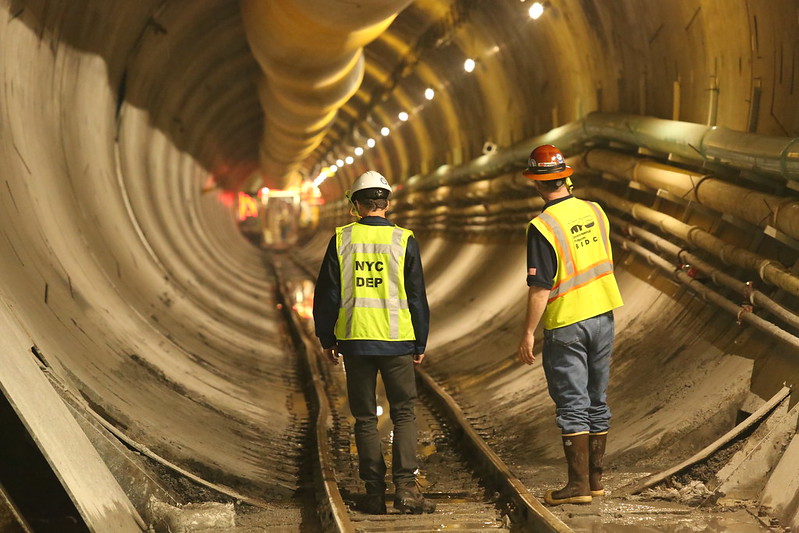New York City Increases Use of Downstate Reservoir Water for Two Weeks During Preparation for Work on Delaware Aqueduct
March 3, 2023
Increased Amount of Water from Croton Watershed from March 6th to 19th May Result in Temporary Taste Difference in NYC’s Drinking Water; Photos of the Delaware Aqueduct Bypass Tunnel are Available here and a Map of the NYC Watershed is Available here
The New York City Department of Environmental Protection (DEP) today announced that from March 6th to 19th there will be a significant increase in the amount of water coming from the Croton Watershed, a group of 12 reservoirs in Westchester and Putnam Counties, to feed New York City’s water supply as engineers prepare for planned work on the Delaware Aqueduct this fall. Due to the increase in Croton water, New York City residents may notice a slight taste difference in their tap water due to different characteristics between upstate reservoir systems.
The increased reliance on Croton water is part of DEP’s largest-ever capital repair project, which calls for connecting a bypass tunnel around known leaks in the Delaware Aqueduct, the world’s longest tunnel. As part of the project, engineers will temporarily shut down the aqueduct for two weeks in March, as a planned test, and then for several months starting in October to make the repairs.
“Nearly 10 million New Yorkers count on us to provide them with high-quality water every single day of the year, without fail, and this complex repair of the Delaware Aqueduct will ensure that we can continue to meet that essential mission for generations to come,” said DEP Commissioner Rohit T. Aggarwala. “The testing being done in March will ensure that all of our equipment and procedures are in place and ready for major work to begin this fall.”
About the Delaware Aqueduct repair project
The 85-mile-long Delaware Aqueduct delivers about half of New York City’s water supply—about 600 million gallons a day—using only gravity, from four Catskill Mountain region reservoirs. The water is held in the Rondout Reservoir in Ulster County, then goes to Hillview Reservoir in Yonkers.
The aqueduct was put into service in 1944 when New York City Mayor Fiorello H. La Guardia opened a set of emergency gates to channel the Rondout Creek directly into the new aqueduct.
In 2010, New York City announced a $1 billion plan to repair the aqueduct by connecting a 2.5-mile-long bypass tunnel around known leaks discovered in the 1990s—one in Newburgh, the other in the Ulster County town of Wawarsing. The new bypass, being connected 600 feet beneath the Hudson River, is the first tunnel built under the Hudson River since 1957, when the south tube of the Lincoln Tunnel was completed.
Since 1992, DEP has continuously tested and monitored the leaks, which can release upwards of 35 million gallons per day. Nearly all of the water escaping the leaks happens near the Hudson River in Newburgh.
DEP has been working closely with Hudson Valley municipalities that rely on the Delaware Aqueduct for their water supplies to activate backup plans during the temporary shutdown as well as working with the U.S. Geological Survey to continually monitor groundwater levels in communities where the Delaware Aqueduct leaks are located.
The major repairs are being done in October because demand for water is at its lowest all year. Even during the testing and shutdown, DEP will continue releasing water into Delaware River tributaries pursuant to the Flexible Flow Management Program, a water allocation agreement between the states of New York, New Jersey, Pennsylvania and Delaware and the City of New York.
About DEP and NYC’s Water Supply
DEP manages New York City’s water supply, providing approximately 1 billion gallons of high-quality drinking water each day to nearly 10 million residents, including 8.8 million in New York City. The water is delivered from a watershed that extends more than 125 miles from the city, comprising 19 reservoirs and three controlled lakes. Approximately 7,000 miles of water mains, tunnels and aqueducts bring water to homes and businesses throughout the five boroughs, and 7,500 miles of sewer lines and 96 pump stations take wastewater to 14 in-city treatment plants. DEP also protects the health and safety of New Yorkers by enforcing the Air and Noise Codes and asbestos rules. DEP has a robust capital program, with a planned $29 billion in investments over the next 10 years. For more information, visit nyc.gov/dep, like us on Facebook, or follow us on Twitter.





